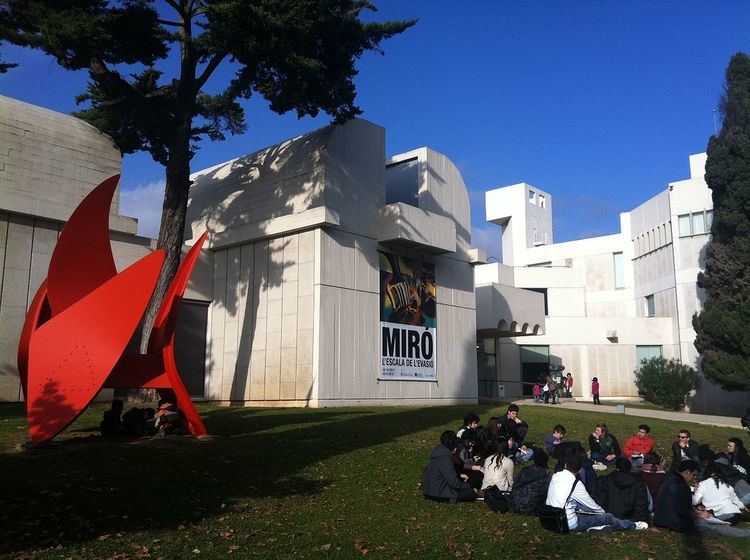Established 1975 Director Rosa Maria Malet Opened 10 June 1975 | Public transit access Montjunc Funicular | |
 | ||
Website Fundació Joan Miró website Hours Open today · 10AM–8PMSaturday10AM–8PMSunday(Father's Day)10AM–3PMHours might differMondayClosedTuesday10AM–6PMWednesday10AM–6PMThursday10AM–9PMFriday10AM–6PM Profiles | ||
35 la fundaci joan mir
The Fundació Joan Miró, Centre d'Estudis d'Art Contemporani ([fun.də.siˈo ʒuˈan miˈɾo], "Joan Miró Foundation, Centre of Studies of Contemporary Art") is a museum of modern art honoring Joan Miró located on the hill called Montjuïc in Barcelona, Catalonia.
Contents
History
The idea for the foundation was made in 1968 by Joan Miró. Miró formed the foundation with his friend Joan Prats. Miró wanted to create a new building that would encourage particularly younger artists to experiment with contemporary art. The building was designed by Josep Lluís Sert to ensure that this work could also be made available to the public and exhibited. He designed the building with courtyards and terraces and to create a natural path for visitors to move through the building.
Building began on the mountain of Montjuïc and the foundation opened on 10 June 1975. Not only was the architect a close friend of Miró but so was the first president Joaquim Gomis and Miró was amongst the first board. It was claimed that the new foundation represented a new way of viewing the concept of a museum and how the people of Barcelona could relate to their cultural heritage.
Expansion in 1986 to the building added an auditorium and a library which holds some of the 10,000 items in the Foundation and Miró's collection.
Works by Joan Miró
Many of the works in the building were donated by the artist himself. Highlights include:
Collection
In line with Miró's original idea the Foundation has a space named "Espai 13" which is dedicated to promoting the work of young experimental artists. Although there is also work by Peter Greenaway, Chillida, René Magritte, Rothko, Tàpies and Saura. The collection includes Alexander Calder's 4 Wings and Mercury Fountain. The Mercury Fountain is a fountain that uses the liquid metal mercury to create a fountain. As mercury is poisonous the fountain is kept behind glass to protect the visitors.
The museum uses QRpedia to allow visitors to read Wikipedia articles about objects in the collection, translated into their preferred language.
Espai 13
The Fundació Joan Miró has had a space for exhibiting contemporary art, with regular and continuous programming. Espai 10, active since 1978, and Espai 13, which took over after 1989 to continue through to the present day, together offer an area of analysis that is unique within Spain and also Europe as a whole. This exhibition space has been working as a laboratory of cutting-edge art, a space for programming experimental exhibitions of contemporary art, and has functioned over more than three decades in a major institution as an art centre within an institution. Besides providing a venue for local artists, it has also been a place of constant international interchange. Moreover, the broad span of over thirty years has made it possible not only to analyse the history of movements, patterns and trends in art but also to detect intersections between different generations and languages. In brief, Espai 10 and Espai 13 provide a privileged place from which to study, moreover, the ways in which theories and socio-political contexts have kept influencing artistic production over the decades when the different kinds of infrastructure that opened up the field of contemporary Spanish and Catalan art were taking shape. Hence, the history of Espai 10 and Espai 13 may be viewed as that of a well-informed witness, or an archive that can be compared and contrasted with many others from the same period.
